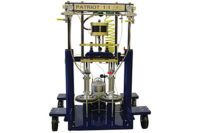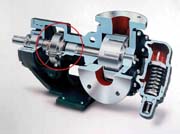
Before getting into the details of pump sealing, a short review of pumping technology will offer an understanding of sealing problems. Pumps are the second most common piece of industrial equipment, next to electric motors. They are divided into two major categories: kinetic and positive displacement (PD). Kinetic pumps move liquid by imparting energy to the liquid by means of an impeller confined in a housing. Rotational velocity of the impeller is key, and these pumps always operate at motor speeds. Positive-displacement pumps move liquid by taking confined amounts of liquid, determined by pumping element geometry, through the pump. Kinetic pumps are often viewed as pressure generators, whereas positive-displacement pumps are viewed as flow generators.
Centrifugal pumps are the most common kinetic pumps and account for about 70% of all pumps sold. Rotary pumps are the most common PD pumps and account for about 15% of all pump sales. Centrifugal pumps do not work well on liquids with a viscosity above 150 cps and will not pull liquid when there is a suction lift. PD pumps work well on a range of liquid viscosities but are the only choice for thicker liquids. They also have excellent vacuum capability - that is, they can pull a suction lift. PD pumps displace the same amount of liquid with each revolution of the shaft, irrespective of discharge pressure, so they are good choices when a predictable amount of output flow is needed. PD pumps generally run at a much slower speed than centrifugal-type pumps.
Most adhesives and sealants are viscous products that make a PD pump necessary. In particular, gear-type pumps are often used because of their design simplicity, ease of maintenance and relative low cost compared with other rotary PD pumps. As with all rotary PD pumps, there is a drive shaft that powers the pump that, by necessity, has to be sealed. Figure 1 shows a typical gear-type pump with the shaft seal circled.
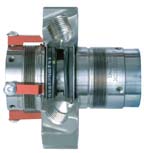
Adhesives and sealants have a range of liquid properties that may encompass any of the following characteristics.
- Wide viscosity range (from a few cps to several hundred thousand cps)
- Shear sensitivity (the liquid viscosity changes or the product degrades with shearing)
- Highly reactive (adhesives by design often react with either air or water)
- High temperature (hot-melt adhesives can go to 350Several years ago, an alternative for conventional shaft sealing means was developed for PD pumps. This design eliminates the need for traditional shaft sealing since the pump is driven by magnetic force through a containment canister. Bar-type magnets on both inner and outer magnetic drive components are used to transmit power through the canister. The pump contains only static seals or gaskets, as the pump drive shaft does not protrude through the pump housing. These pumps are commonly referred to as mag drive; Figure 3 shows a typical assembly.
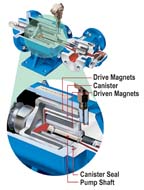 Figure 3. A Typical Assembly
Figure 3. A Typical AssemblyMag drives have been around for many years, though they were not widely used in PD pumps because of the relative high torque required for them. It was not until high-strength magnets were introduced into the automobile industry on a mass-production basis that the value proposition made sense for pumps. Magnetic couplings now could be designed to transmit the torque required for PD pumps, and high production brought costs within reach.
The benefits of mag drive technology for hard-to-seal liquids are many.
- Lower maintenance costs
- Longer pump life
- Increased uptime (or less downtime, if you will)
- No costs associated with an auxiliary barrier fluid system
- Eliminated environmental risk due to seal leakage
Although the initial expense of mag drive pumps is higher than comparable mechanical seal installations, the benefits outweigh the costs. Some installations have partially offset the higher first cost by using a smaller pump. This may seem strange, but in these instances a larger pump running at a slower speed was chosen to extend the life of the seal. Even though a smaller pump would handle the application, the life of the seal was the controlling factor, and the slower pump-speed helped extend seal life. Approaching the application with a mag-drive pump allowed the use of a smaller pump running at a faster speed to attain the same flow. All of the benefits above were realized with the added bonus of having the higher cost of the mag drive partially offset by using a smaller pump.
Mag-drive rotary pumps cover a wide application range. They are suitable for viscosities from 0.1 cps to 50,000+ cps. Models are available that can handle 200 psi differential pressure and flows to 500 GPM. With special magnets and elastomers, temperature can go to 500
Another class of pump, air-operated double-diaphragm (AODD) pumps, is also considered sealless. These pumps are not technically positive displacement since they are driven by a compressible fluid - air. AODD pumps perform more like centrifugal pumps; flow goes down with increasing dishcarge pressure. This is because the air pressure that drives the pump is compressible, so for higher pressure, air flow goes down and hence pump output flow. However, AODD pumps are different from centrifugals and more like PD pumps in that they will pull a suction lift. Sealing and moving liquid with AODD pumps is accomplished by opposing flexible diaphragms, and there is no rotary shaft seal involved. A typical AODD pump is shown in Figure 4.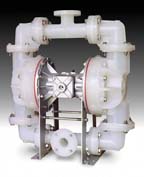 Figure 4. A Typical AODD Pump
Figure 4. A Typical AODD PumpAODD pumps realize the same benefits of sealless design but are more limited in application envelope. These pumps can accommodate flows to 300 GPM, but are limited to 125 psi discharge pressure or the pressure of the available air supply. Flow output is pulsing and they are limited in temperature to 225
This article is based on a paper presented at the Fall 2004 Adhesive and Sealant Council, Inc., Convention in Pittsburgh.For more information on sealless pump technologies, contact Viking Pump Inc., a unit of IDEX Corp., 406 State Street, P.O. Box 8, Cedar Falls, IA 50613-0008; phone (319) 266-1741; fax (319) 273-8157; e-mail info.viking@idexcorp.com; or visit http://www.vikingpump.com.
